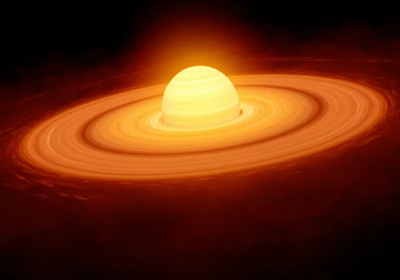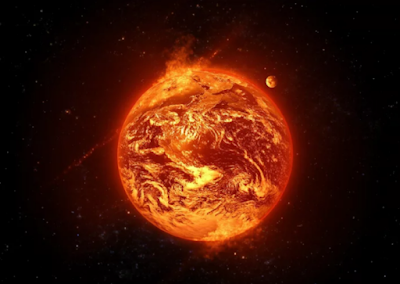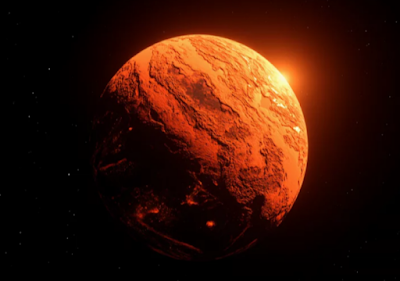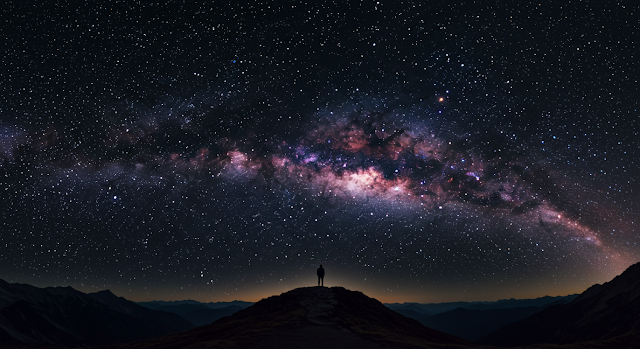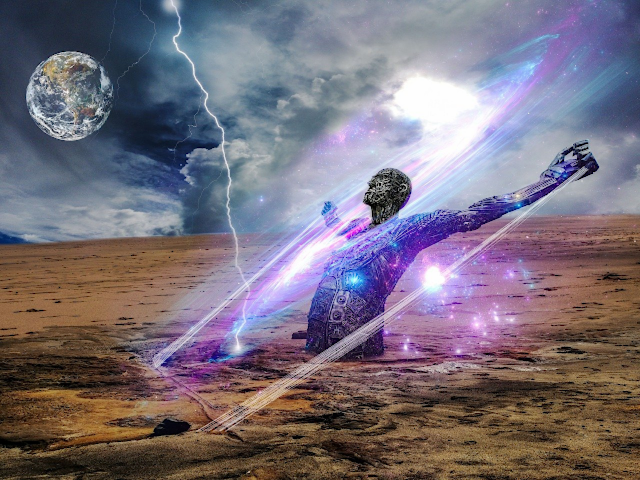Have you ever just sat outside on a clear night, looked up at the stars, and felt that overwhelming sense of… well, of *wonder*? It’s a feeling I chase all the time. You see the Moon hanging there, the faint river of the Milky Way, and the question just pops into your head: How did any of this get here? How did we go from an empty, dark void to… this? A planet teeming with oceans, forests, cities, and us.
It’s a story that starts 4.6 billion years ago. Our Earth wasn’t the “blue marble” we know and love. It was a hellscape—a boiling ball of lava, constantly smashed by space rocks. So, how did that ball of fire transform into our home? It’s an epic tale involving dying stars, cosmic dust bunnies, and a planetary collision of unimaginable scale. Today, we’re going to dive deep into the origin of the Solar System and the incredible, violent formation of the Earth. Buckle up, because this is the ultimate cosmic history lesson.
I’m a passionate science communicator, but I’m not a professional astrophysicist or geologist. The information in this article is based on widely accepted scientific theories and data from sources like NASA and peer-reviewed studies. This is for educational and entertainment purposes!
From Cosmic Cloud to Blazing Star: The Solar System’s Fiery Birth
Before there was an Earth, a Sun, or anything else, there was just… a cloud. But not just any cloud. Picture a colossal, swirling expanse of gas and dust drifting through the silent darkness of space. Astronomers call this the Solar Nebula. For millions of years, this was our neighborhood—a peaceful, cold cloud made up mostly of hydrogen and helium, the lightest and most abundant elements in the universe.
Then, everything changed. Somewhere nearby, a massive star reached the end of its life and went out with a bang. A really, *really* big bang. It exploded in a cataclysmic event called a supernova. The shockwave from this explosion ripped through space and slammed into our peaceful little nebula. This wasn’t an act of destruction, but of creation. The shockwave compressed pockets of gas and dust, causing the entire cloud to start collapsing in on itself under its own gravity.
As it collapsed, it started to spin, faster and faster, like a figure skater pulling in their arms. The cloud flattened out into a massive, rotating disk. We call this the protoplanetary disk—literally, the “before planets” disk. This simple act of flattening is why all the planets in our solar system orbit the Sun on roughly the same plane! It’s not a coincidence; it’s a fossil of our cosmic birth.
At the center of this spinning disk, things got really intense. Gravity pulled more and more material inward. The pressure and temperature skyrocketed. When it hit about 15 million degrees Celsius (that’s 27 million degrees Fahrenheit!), a miracle of physics occurred: nuclear fusion. Hydrogen atoms began fusing together to create helium, releasing an unimaginable amount of energy. In that brilliant flash, our Sun was born.
The Ultimate Snowball Effect: How Planets Were Built from Dust
So, the Sun was born, but what about that leftover 0.2% of dust and gas spinning around it? This is where the story gets really cool. Think about the dust bunnies under your bed. They start as tiny specks, then they stick together, gathering more lint and hair until they become noticeable clumps. The formation of planets worked in a surprisingly similar way, a process called accretion.
Initially, tiny dust particles in the protoplanetary disk started clumping together due to static electricity. Little zaps holding them together. As these clumps grew, their gravity increased, allowing them to pull in more and more dust and pebbles. Over millions of years, these clumps grew from pebbles to boulders, and then to bodies several kilometers wide. We call these planetesimals—tiny planets.
These planetesimals were like bumper cars in a cosmic rink, constantly colliding. Sometimes they’d shatter, but often they’d merge, creating even bigger bodies. When a planetesimal grew to be about the size of our Moon, it earned the title of protoplanet. The inner solar system, where it was hotter, was full of rocky protoplanets. The outer solar system, where it was colder, had icy ones that would eventually become the gas giants.
The Father of Accretion Theory
The idea of accretion was formally proposed by a Soviet astronomer named Victor Safronov in 1969. For years, his work was largely ignored by the Western scientific community. It wasn’t until the 1980s that his brilliant hypothesis was rediscovered and became the leading model for planet formation. It’s a great reminder that great ideas can come from anywhere!
How do we know this isn’t just a wild guess? We have evidence! When meteorites fall to Earth, they often contain tiny, ancient, spherical grains called chondrules. These are like fossilized droplets of molten rock from the original solar nebula, frozen in time before they ever became part of a planet. They are the original building blocks, and by studying them, we can piece together the story of the origin of our solar system.
Welcome to Hell on Earth: The Hadean Eon 🔥
Through countless collisions and mergers of protoplanets, our own home planet began to take shape. But the early Earth was anything but homey. This first geological eon, lasting from about 4.6 to 4 billion years ago, is aptly named the Hadean Eon, after Hades, the Greek god of the underworld. It was, quite literally, hell on Earth.
The planet was a molten ball of magma, kept hot by the intense energy of constant collisions. There was no solid ground, no water, and no air to breathe. Giant asteroids and comets, leftovers from the solar system’s construction phase, relentlessly bombarded the surface. An impact from a 200-km-wide asteroid would have been a routine event, vaporizing rock and creating temporary atmospheres of silicate vapor.
But amidst this chaos, something amazing was happening. Those very comets and asteroids that were pummeling our planet were delivering a precious cargo: water. Comets are essentially dirty snowballs of ice and rock, and asteroids can also contain significant amounts of water locked within their minerals. As they smashed into Earth, they deposited this water, which instantly turned to steam and shrouded the planet in a thick, dense atmosphere. This was the first step toward creating our oceans.
The Great Separation: How Earth Got Its Layers 🧅
As the constant bombardment began to slow down, Earth started a process that would define its future structure. It’s called planetary differentiation. Think of it like a bottle of vinaigrette dressing. When you shake it, everything is mixed together. But if you let it sit, the oil and vinegar separate into layers based on their density. The same thing happened with Earth.
When Earth was a thoroughly mixed, molten ball, the heaviest elements began to sink. Gravity pulled dense materials like iron and nickel down to the center of the planet. This “great iron catastrophe,” as it’s sometimes called, formed Earth’s metallic core. Meanwhile, lighter silicate minerals—compounds of silicon and oxygen—floated upward, like cream rising to the top. This material would eventually cool to form Earth’s thick mantle and its thin, rocky crust.
| Layer | Primary Composition | State | Key Feature |
|---|---|---|---|
| Crust | Silicon, Oxygen, Aluminum | Solid (Brittle) | Where we live! Divided into tectonic plates. |
| Mantle | Iron-Magnesium Silicates | Solid (but flows like taffy) | Drives plate tectonics through convection. |
| Outer Core | Iron, Nickel | Liquid | Generates Earth’s magnetic field. |
| Inner Core | Iron, Nickel | Solid | Intense pressure keeps it solid despite extreme heat. |
This separation was crucial. The liquid outer core, with its churning molten iron, acts as a giant dynamo, generating Earth’s magnetic field. This magnetic field is our planet’s invisible shield, deflecting harmful solar winds and cosmic radiation that would otherwise strip away our atmosphere and make life impossible. Without differentiation, we wouldn’t be here.
The Big Splat: The Violent Birth of Our Moon 🌕
There’s one more giant piece of the puzzle we need to place: the Moon. For a long time, scientists debated its origin. Was it a passing object captured by Earth’s gravity? Did it form alongside Earth? Did a chunk of a rapidly spinning Earth just fly off? It turns out, the truth is far more dramatic.
The leading theory today is the Giant-Impact Hypothesis. It proposes that about 4.5 billion years ago, when the formation of the Earth was nearly complete, it didn’t have a moon. Instead, there was another protoplanet orbiting the Sun nearby, an object about the size of Mars that scientists have nicknamed Theia.
Theia’s orbit was unstable, and it eventually went on a collision course with Earth. The resulting impact was an event of almost unimaginable violence. Theia slammed into the young, molten Earth, not head-on, but at an angle. The collision merged the iron core of Theia with Earth’s core and blasted a massive cloud of vaporized rock and debris from both planets’ mantles into orbit.
This ring of super-heated debris didn’t just float away. Over thousands of years, gravity pulled it all together, and it coalesced to form our Moon.
This violent birth was incredibly fortunate for us. The impact is thought to have knocked Earth over, giving it its 23.5-degree axial tilt. Without this tilt, we wouldn’t have seasons. The climate would be drastically different and much more extreme. Furthermore, the Moon’s strong gravitational pull stabilized Earth’s wobble and created the ocean tides. Some scientists believe these tides were crucial for early life, creating dynamic coastal pools where organisms could transition from sea to land.
The Recipe for a Habitable Planet
Supernova Shockwave
A nearby exploding star provided the initial push to collapse the solar nebula, kickstarting the whole process.
Accretion & Formation
Dust and rock stuck together over millions of years to build the rocky planet we call Earth.
Cometary Water Delivery
Bombardment by ice-rich comets and asteroids during the Hadean Eon delivered the water that would form our oceans.
Planetary Differentiation
The separation of layers created a protective magnetic field and concentrated the right materials for a stable crust.
The Giant Impact
A collision with a protoplanet named Theia formed our large Moon, which stabilized our axis and created life-nurturing tides.
Just the Right Spot
Being in the “Goldilocks Zone”—not too hot, not too cold—allowed liquid water to exist on the surface.
The “Goldilocks” Planet: Why Earth Was Just Right for Life 🌏
As the Hadean Eon gave way to the Archean Eon, the Earth finally started to cool. The steam in the atmosphere condensed and fell as rain—a torrential downpour that may have lasted for millions of years, filling the basins and creating the first oceans. Volcanic activity continued to release gases, forming a primitive atmosphere rich in carbon dioxide, methane, and water vapor, but critically lacking in free oxygen.
When you look back at this entire, chaotic story, it’s astonishing how many things had to go exactly right. The complete story of the formation of the Earth is a series of fortunate accidents and precise conditions.
- If our Sun were bigger, it would have burned out long before complex life could evolve. If it were smaller, Earth might be a frozen ice ball.
- If Earth were smaller, its gravity wouldn’t be strong enough to hold onto an atmosphere. If it were much bigger, it might have held onto a crushing hydrogen-helium atmosphere like Jupiter.
- Without the magnetic field, solar radiation would have sterilized the surface.
- Without the Moon, our climate would be wildly unstable.
- Without the delivery of water by comets, we’d be a dry, dead rock like Mars.
Our planet is a testament to a 4.6-billion-year journey of chance, physics, and violence. From a silent cloud of dust to a raging ball of fire, and finally, to the living, breathing world beneath our feet. It’s a story that should fill us with awe and a profound sense of responsibility to protect this incredibly rare and precious home.
Frequently Asked Questions ❓
Where did Earth’s water really come from?
The leading theory is that most of it was delivered by water-rich asteroids and comets that bombarded Earth during the Hadean Eon. Some water was also likely trapped in the original minerals that formed the Earth and was later released through volcanic activity.
How do we know the Earth has layers like a core and mantle?
We can’t drill to the center of the Earth, so scientists use an indirect method: studying seismic waves from earthquakes. The way these waves travel, reflect, and bend as they pass through the planet reveals the boundaries between different layers and tells us whether they are solid, liquid, or plastic-like.
Could life have existed on Earth without the Moon?
It would have been much, much harder. Without the Moon to stabilize our axial tilt, Earth’s climate would swing wildly between extreme hot and cold periods, making it very difficult for complex life to gain a foothold. The lack of significant tides would have also changed the course of evolution.
What part of Earth’s origin story blows your mind the most? For me, it’s the Giant Impact that created the Moon. The idea of two planets colliding is just epic. Drop a comment below and let’s geek out together!

